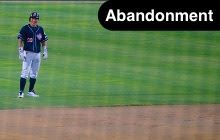The following UEFL Video Rulebook entry pertains to "out" calls. An
out is one of three events necessary for the defensive team to retire the offense during an inning.
The defense's objective is to obtain three outs during an offensive team's time at bat (during the half inning in which the defense's opponent is at bat). Outs may be obtained in the following ways; click each image to be taken to a video example illustrating the designated term:
 |
| If the defensive player possesses the ball and touches a base to which a runner is forced to advance prior to said runner achieving that base (first base for the batter), the runner is out. |
|
 |
| A runner tagged by the defense while not touching a base is out. Tag means that the defense possesses the ball and touches the runner with the ball or glove, if the ball is held by the glove. |
|
 |
| A batted ball in the air which is caught by the fielder before touching the ground, wall, an umpire, or offensive player (it may touch another fielder), is a catch and an out. |
|
 |
| When the batted ball is hit on the infield and being fielded to (thrown towards) first base, the batter-runner must stay within a three-foot lane which is drawn along the last 45 feet between home and first base. If the batter outside of the running lane interferes with the player at first base taking the throw, the batter is out. |
|
 |
| A runner's base path is a straight line drawn from his instantaneous position to the base he is trying for. The line is drawn at the moment the defense attempts to make a play (tag) the runner. If the runner deviates by more than three feet from his base path in an attempt to avoid a tag, the runner is out for leaving his base path. |
|
 |
| A fielder has the 'right of way' to any batted ball while the runner has the 'right of way' after the fielder has attempted (successfully or otherwise) to field the batted ball. When the batter hits a fly ball in the air and illegal contact occurs between runner and the fielder trying to catch the fly, the interfering runner is out (air out). |
|
 |
Similar to the fielder's right of way on a fly ball, the batter can interfere with the catcher in one of two ways:
1) On a batted ball, he impedes the catcher from playing the ball;
2) On a stolen base attempt or similar event, his actions in leaving the batter's box impede the catcher's ability to make a play on the runner. |
|
 |
| Abandonment in theory is similar to the out of the base path call, yet distinct from this call, in that the fielder's actions are irrelevant. If the umpire deems the runner is making no effort to run the bases (advance or retreat), for instance, by running away from the infield, the runner may be called out for abandoning his offensive duties. |
|
 |
When the infield fly is invoked, the batter is out, runners are not forced to advance, and the ball remains live. The following criteria must be satisfied for a call of 'infield fly':
1) Less than two outs;
2) Would-be force out at 3rd base;
3) Hit is a fair fly ball an infielder can catch with ordinary effort. |
|
 |
| A batter or runner is out for interference with a batted ball when he makes contact with the batted ball in fair territory before an infielder (not including the pitcher) has had a chance to field the ball. If any defensive player touches the ball first, accidental contact is incidental/legal. |
|
 |
| The fielder's 'right of way' extends to any type of batted ball. The umpire judges which individual fielder is entitled to field a particular batted ball and this one person is given the 'right of way' to attempt to field the batted ball. Interference also occurs when a coach/player put out assists a runner. |
|
 |
(SEE BONA FIDE SLIDE RULE)
When a runner intentionally interferes with a fielder in an attempt to break up a double play, the umpire may rule both that runner and the batter-runner out for the illegal actions of his teammate. As with other interference, the ball is dead at the time of INT. |
|
 |
When the defense believes the offense has violated a rule, a live ball appeal is filed by tagging the base where the violation occurred. Appeals include:
> Failure to touch or retouch a base;
> Failure to tag up on an air out;
Additional dead ball appeals (e.g., batting out of order) are filed verbally. |
|
 |
| A trailing runner is declared out immediately upon passing the runner who precedes him. For passing to occur, the trail runner's entire body must fully pass the entirety of the lead runner's body (or fully past the base still touched by the lead). A runner not yet out who touches or pushes another runner is legal and not alone passing. |
|
 |
(SEE HP COLLISION RULE)
A runner attempting to score must make an effort to touch home plate (as opposed to bowl over a catcher). If a runner appropriately slides, he is not in violation of this rule. If the runner goes out of his way to contact the catcher, he is out for the collision. |
|

























0 comments :
Post a Comment